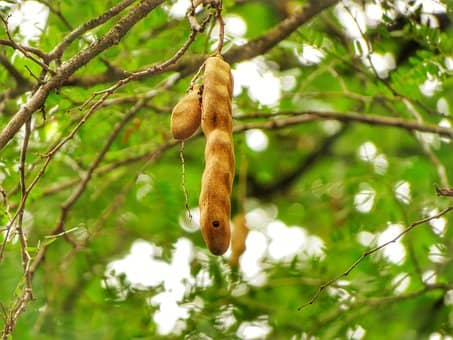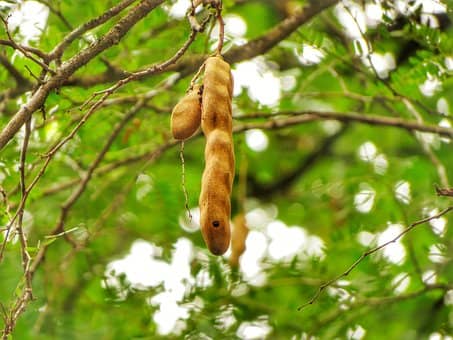Tamarind cultivation is done throughout the world and India is the largest producer of this sweet sour fruit. It is known as imli in India and used in food items, cosmetics, medicines and toffees etc. Tamarind farming profit is good enough and shared in this post along with other important information. Tamarind fruit in Hindi is popularly known as imli and Indians are fond of it, especially ladies who like its sour taste.
Tamarind tree
Tamarind (Tamarindus indica) is a leguminous tree well known for its sweet and sour edible fruits. The tree is dense and indigenous to tropical Africa and belongs to the Fabaceae family. The tree produces brown fruits that look like pods that contain sweet, tangy pulp which is used in cuisines around the world. Its pulp has great demand in the market due to its use in traditional medicines and metal polish. Moreover, wood is used for woodworking and seed oil can be extracted from the tamarind seeds.
Tamarind tree growing zone
Tamarind has multiple uses therefore it is cultivated in tropical and subtropical regions all over the world. Due to its multiple uses and basic cultivation practices, it falls under easy cultivation crops, therefore, it is a worldwide popular tree and farmers are growing tamarind in the UK, farmers are also growing tamarind in Florida, Arizona, Texas, Melbourne, Poland etc.
Uses
Not only in India tamarind fruit in America is also very popular because of its fresh juicy taste. Due to its sweet and sour taste, it is used in curry, chutney, soup and sauces. It has acidic and laxative properties. Its kernel powder is used in the leather and textile industry and seed oil uses in paint and varnishes. Wood is used as agricultural tools and tamarind gum which is obtained from seed powder is used as a sticking agent.
Project Report
| Cost per acre Land preparation = Rs 5000. Planting material = Rs 10,000. Manure and fertilizer = Rs 8000. Plant protection charges = Rs 4500. Irrigation charges = Rs 5500. Miscellaneous cost = Rs 4500. Packaging material cost = Rs 2800. Total cost = Rs 40,300. First 3 years you will not earn anything, fruits will appear in the 4th year. So we need to calculate the cost for 4 years. But first, reduce the plant material cost from the total cost because it is a one-time investment. Rs 40,300 – Rs 10,000 = Rs 30,300. Now calculate 4-year cost: 4 year cost = Total cost (Rs 30,300) x 4. Total cost = Rs 121200. Now add the plant material cost = Rs 121200 + Rs 10,000. Total cost for 4 years = Rs 131200. Tamarind yield per acre To get tamarind farming profit we have to calculate Tamarind cost per kg = Rs 80, Rs 90 and more depending on the variety. If the price is Rs 70. The average tamarind yield per acre is 10 tonnes. 10 tonnes = 10,000 kg. Profit = Rs 70 x 10,000 kg = Rs 700000. Net Profit = Profit – Cost per acre. Net Profit = Rs 5,68,800 (7,476.39 USD). Note – This is a well-researched project report. However, the price may vary according to the varieties, market, location etc. |
Top tamarind producing states in India
India is the largest tamarind-producing country in the world. Tamarind cultivation in Andhra Pradesh, Telangana, Tamilnadu, Orissa, Bihar and Maharashtra is done on a large scale.
Varieties
PKM 1 This variety is able to produce 250 to 300 kg pods per tree with 40% pulp. By applying this variety one can produce 15 tonnes of pods per acre.
Urigam – This variety produces sweater-long pods.
Tamarind cultivation

With good farm management practices such as proper irrigation, timely weed removal process, ideal land preparation for farming, soil testing and soil selection, intercultural farming practices, the proper amount of fertilizers and pesticides, organic fertilizer and FYM etc cultivation becomes effective. All these best practices are given below step by step.
Climate
Well! The good thing is that tamarind tree-growing zones are vital and growing these trees is possible in any climate. The ideal growing zone is semi-arid tropical regions with rainfall of 5 cm to 15 cm. However, it can also grow in heavy rainfall regions where land has a proper internet drainage system.
Temperature
Tamarind is a temperature tolerating crop that can easily survive at 0 °C as well as above 45 degrees Celsius.
Soil requirements
The speciality of this crop is it can tolerate varying temperatures and it can grow in poor soil also. However, the ideal soil to grow tamarind easily is loam and alluvial soils.
Soil pH
Tamarind cultivation can be easily done with a pH ranging from 4.5 to 9.0.
Methods of planting
Plantation can be done through seeds, grafts and buddings.
Seeds – Growing with seeds takes nearly 7 days to 10 days to germinate. After three to four months tamarind seedlings are transplanted into the main field. In order to achieve a higher yield you should perform softwood grafting in tamarind cultivation.
Plantation spacing – Prepare pits with 1x1x1 and maintain a distance of 10 m x 10 m and add 15 to 20 kg FYM along with topsoil. From time to time irrigation is necessary to get higher and better fruit yield.
Tamarind trees per acre
400 to 500 plants can be planted in 1-acre farming.
Growing season
June to november is the idle time for planting.
Fertilizer
During the land preparation and before the plantation applies fully decomposed organic cow dung and organic manure.
Irrigation
This plant does not demand much water but at the beginning stage of the plant, water is required at the proper time.
Summer season – Frequent irrigation is required during the summer season.
Rainy season – No irrigation is required during the rainy season instead remove the standing water with the proper drainage system.
Weed control
Mulching is the best practice to control weeds hence mulching is done after the ploughing process. It is recommended to perform a mulching process because mulching is helpful to retain soil moisture. If you don’t know what is mulching in agriculture and its application process then please use our search box and type mulching techniques in agriculture.
Harvesting season
Tamarind tree harvest time can be classified according to the plantation method. If it is grown through seeds then harvest time will be longer and it may take up to 8 years for the first harvesting. Whereas growing it from cuttings takes less time to reach harvesting. While using the grafting method the yield can be seen from the 4th year.
Is tamarind tree cultivation profitable

Tamarind cultivation benefits are limitless due to its multi-purpose uses. They are harvested twice for the properties once they are harvested when they are not completely ripe and are in raw form. Raw tamarind is used in pickles and consumed raw due to its sour taste, pickles have good market value. They were again harvested when they were completely ripe, this time they gave a sweet and sour taste.
Completely ripe tamarind has more demand in local and international markets because it can easily be transported to other countries in the form of paste. Not only do its fruits have good demand in the market but also leaves, seeds and wood have a great demand due to multipurpose uses.
Health benefits
Tamarind is good for the heart.
It improves the digestive system.
It is good for skin.
This edible fruit is a good source of iron.
Contains a sufficient amount of minerals.
Its regular consumption is good for diabetic patients.
My experience as a kid – I used to play a game of hide and seek on a tamarind farm which was located in Secundrabad, India. Not only on the farm there were more than a couple of trees near our houses. While playing the game I sometimes hide in its branches and the tree was so dense other kids were hardly able to find me.
FAQ
How long does it take a tamarind tree to bear fruits?
The tree takes 4 years from the planting period to produce fruits. This is for grafted or budded plants. While growing it by seeds takes 8 years to bear fruits.
How long does it take to ripen completely?
The fruit takes at least 6 months to get ripen completely and become edible.
How long does it take to grow a tamarind tree?
This dense tree will grow tall within 1.5 years but the grafted plants will start bearing fruit from the 4th year and the seed propagated plant will take 8 years from the planting to bear fruits.
What is the lifespan of a tamarind tree?
Approximately 200 years.
What is the tamarind fruit yield per tree?
250 to 300 kg is the tamarind yield per tree.
What is the tamarind yield per acre?
On average it can produce 8 to 10 tonnes of fruits per acre.
How many tamarind trees per acre should I plant?
400 to 500 plants should be planted in 1 acre for higher yield.
What is the tamarind cultivation profit per acre?
With the best farming practices, farmers can make approximately Rs 5,68,800 (7,476.39 USD) from a one-acre farm.